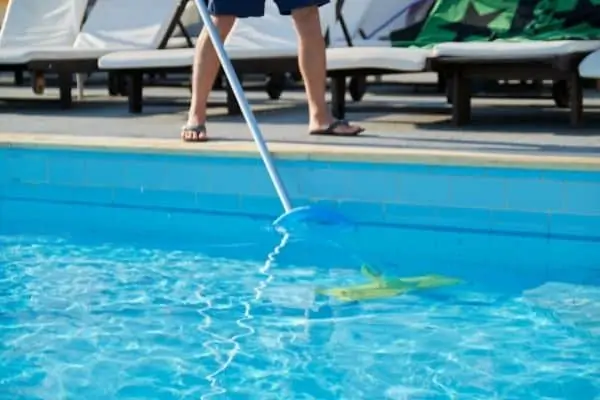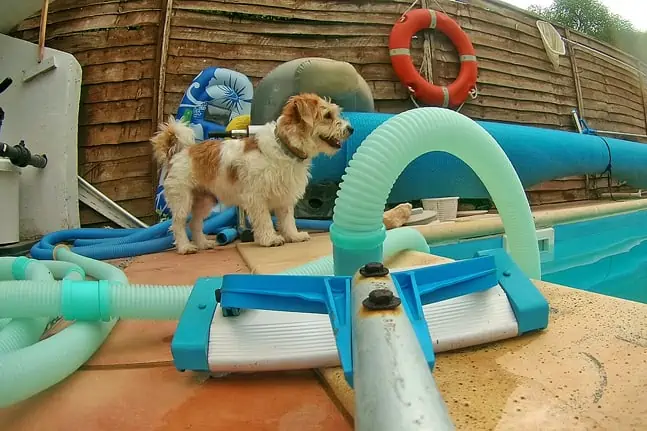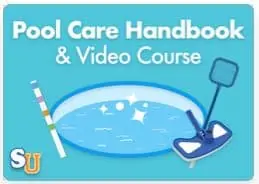It would be wonderful if a pool would look after itself so you could put your feet up and lie on a sun lounger instead. Unfortunately, that is not the case – unless you can afford a pool service to do all the work.
Vacuuming a pool once a week is normally sufficient. However, it may need to be vacuumed sooner if it has been used excessively, if debris has been blown into it by a big storm, or if it is under trees, so leaves frequently fall in.
Vacuuming a pool is important, but it is just one of the many actions required to keep it clean and healthy.

How often should you vacuum your pool?
In normal use, during the swimming season, how often to vacuum pool surfaces will normally not be more than once a week.
But there will be times when you will need to vacuum your pool more often, such as:
Heavy Use
If your pool gets very heavy use, particularly with children, you will likely need to vacuum more frequently. Most children love to keep getting out of the pool, run around and then jump back in. When they do this, they take dust, grass and who knows what else back into the pool.
Of course, it isn’t just children that may bring debris into the pool with them. Adults can also be the culprits.
Fall
In the fall, particularly if trees are around or near the pool, it will be necessary to vacuum more frequently. Leaves and any form of organic matter that may sit on the bottom of a pool will promote algae growth, which you definitely do not want. So, regular vacuuming and removing leaves with a net during fall may be necessary 2-3 times a week.
After a storm
If you have a storm, particularly with strong wind, dust and other debris will probably end up in the pool. Ideally, you should do it as soon as possible, not just wait until your next weekly vacuum.
Here in the Canary Islands, we have a strong wind called a Calima every few months. This wind brings lots of dust from the Sahara desert, so I need to vacuum my pool as soon as it is over.
Algae
If you should get a build-up of algae, then, as well as using chemicals, more frequent vacuuming, perhaps to waste, might be required. In this situation, brush the walls and the floor thoroughly before vacuuming.

Get into a pool maintenance schedule
If you leave your pool between vacuuming and don’t do anything else, you will just be making more work for yourself in the long run. Ideally, you need to get into a routine and carry out a few tasks that will only take a few minutes but make life easier.
Hopefully, these pool maintenance tips and checklists will help you keep your pool in good order.
Daily
In an ideal world, you should try to carry out these simple tasks daily. They won’t take you more than 5-10 minutes each day. We all have busy lives, so that isn’t always possible. But the more frequently you can do them the easier cleaning will be and the healthier your pool will be.
- Using a pool net, skim any leaves, insects or other floating debris off the pool’s surface. This will make the pool look nicer and more inviting and prevent the skimmer baskets from clogging.
- Visually inspect the pool for algae or other obvious problems. If there is, you will need to take action, probably by doing a full weekly clean.
- If leaves or other debris are on the paving around the pool, sweep or pick them up to prevent them from being blown into the pool.
- If the weather is not so warm, then consider pulling the solar pool cover over to preserve water heat if you have one.
Twice weekly
As well as doing the daily tasks above, you should:
- Check the skimmer baskets and empty them if necessary. If your pool is near or under trees, it may be necessary to do this daily in the autumn.
- Using a pool brush, brush around the pool sides and down to remove any algae or dirt clinging to them.
- Brush the pool steps or the rungs of the pool ladder, to remove any dirt
- Brush any dirt from the pool’s corners or other areas where dirt accumulates and doesn’t go through the pool filter.
- Check the water temperature if you live in a warm climate and have solar pool heating and/or a solar pool cover. In hot, sunny weather, it can climb remarkably quickly. If it is getting too warm for swimming, shut off the heating or remove the cover. I left mine covered and with the solar heating on for a week one summer when I was ill, and when I checked, the pool temperature was almost 100ºF (37ºC), which was nearly as hot as my hot tub!
- If the pool is used often (when family stays, for instance), I will check the water condition using a test strip or whatever other method you use and add chemicals as necessary. Otherwise, I normally do this once a week after cleaning.
Weekly
This is the only real work you must do to keep your pool orderly. It shouldn’t take more than an hour once you get into the swing of things. An average week generally takes me 45 minutes from start to finish.
Ideally, you should do this either before anyone goes in for a swim or at least an hour after the last swim. This is because the swimmers will disturb any dirt in the pool, which will now be floating in suspension in the pool water. You need that dirt to settle on the bottom so you can vacuum it, which will take at least an hour.
- If the pool level has dropped due to evaporation and you don’t have an automatic top-up, use a hose to bring the water up to the correct level. If the pool is very dirty, you will need to vacuum to waste rather than on the filter setting, then top the pool up further as water will be lost during the vacuuming process.
- If your pool bottom has many leaves, use a pool rake or pool net to remove as many as possible. Try to do this as gently as possible to avoid disturbing fine dirt. If you do, leave it to settle again before vacuuming.
- Carry out the twice-weekly tasks above for brushing and emptying the skimmer baskets. If you can, leave it 30 minutes or so after brushing to give the dirt a chance to settle on the bottom before you start vacuuming.
- Connect your pool vacuum to the pool pole and vacuum hose, and then, after removing the air from the pool hose, connect it to the skimmer or dedicated vacuuming port if you have one.
- Vacuum the pool, taking your time to avoid disturbing the dirt as you go.
- If vacuuming on the waste setting, keep an eye on the water level. If it reaches the bottom of the skimmer, stop vacuuming and top the pool up again before continuing.
- When you have finished, remove the vacuum from the pool.
- Check to see if the filter needs backwashing and rinsing. When you vacuum, dirt gets trapped by the filter, and after a while, it becomes clogged, so back pressure builds up, and the suction reduces. If you noticed the suction reduction while you were vacuuming or the filter pressure gauge is now higher than normal, you may need to do this. To find out how to do this, read my guide to backwashing.
- Check the pool pump strainer basket through the see-through lid for leaves and other debris. If there are, set the filter to closed, shut off any valves into the pump, and then remove and empty the basket.
- Replace the skimmer baskets if you have left them out
- Now is the time to check the pool water chemistry to establish the chlorine levels, the pH, the alkalinity etc and add whatever may be necessary.
- You are now pretty much finished. Unless you have just shocked the pool, then I suggest you go for a swim. If you do, that is a great time to clean along the waterline to remove any marks or other stuff there. I always do this as it is much easier than breaking my back bending over the edge.
Every two weeks
It is good practice to shock your pool every other week (or perhaps even weekly if it is being used heavily). This will eliminate any contaminates and ensure the clarity of the pool water.
As and when
Check that the pipework around your pool pump and anywhere else it is exposed is free of leaks.
Check your skimmer housings for signs of any cracks and that the skimmer weir is operating correctly.
If you have an automatic pool top up system you would be unaware if the pool has sprung a leak. So very occasionally tie up the ballcock so water won’t come in when the level drops for a week and see how much the water level goes down. It will inevitably go down a bit due to evaporation, particularly if it is warm and windy, but if it is significant then you need to investigate why is the pool losing water.
Download a full maintenance schedule checklist pdf in this post.

What are the benefits of vacuuming a pool?
There are more benefits when you vacuum a pool other than the obvious one of making it look clean and more appealing.
If you keep the pool clean by vacuuming, you will use fewer chemicals to maintain the water quality. That is because chlorine, etc., is used up quickly if it has to attack the dirt in the pool. By keeping it clean, there is less for the chlorine to do—so you save some money!
The more dirt in the pool, the more likely it is that algae will start to build up, and the pool may start to get that awful green appearance, particularly on the sides of the pool.
My pool pump has low suction
To vacuum a pool successfully, you need a good level of suction. Otherwise, the larger particles will be left on the bottom of the pool. If your suction is low, then this could be for several different reasons, including:
- There could be an air lock in the system. Check that there is water in the pump strainer by looking through the transparent lid. If you can see it is full, then that is not the problem. However, if you can see there is no water or perhaps a small amount flowing through then, there is air in the system. Try opening the valve on the top of the filter housing to release any air. Also, try closing some valves into the pump (but not all) to see if you can clear it. Check that the pump strainer lid is on correctly and the O-ring is in good condition and not letting air in.
- If your pool is particularly dirty, with lots of leaves on the bottom, check that the vacuum head or the vacuum hose is not blocked.
- Some air may be getting into the system. Check that you don’t have a hole in the vacuum hose somewhere or, if you have a join in the hose, that it is tight.
- Ensure the pool water level is correct and not below the bottom of the skimmer.
- Ensure that the pump strainer basket is not full and, therefore, clogged. This will prevent the flow of water and reduce the suction.
- If the pool pump loses suction after a few minutes of vacuuming then this is probably because there is too much back pressure in the filter. Try backwashing and then starting again to see if the suction is restored.
Read: My pick of the best pool vacuum heads
Why is my pool dirty after I vacuum it?
There could be a few reasons for this:
- You are vacuuming too fast. Instead of the vacuum head sucking up all of the dirt on the bottom, it is disturbing much of the dirt which goes into suspension in the water and then after an hour or so, it settles back on the bottom.
- You are not getting sufficient suction through the vacuum to pick up all the dirt. This could be because you need to shut off all the other skimmers, other than the one you are using. You may have a separate valve to do this. If not, I use a tennis ball which I push down into the skimmer hole to stop that one sucking in water. The suction holds the ball in place. By doing this all of the pump suction will be directed to the skimmer you have plugged the vacuum into.
- Your filter may be clogged and need backwashing so some of the dirt you picked up is going back into the pool.
- Check that you did not vacuum on the recirculate setting on the filter’s multiport valve. If you did, the dirt would be sent straight back into the pool. You should only vacuum on the filter or the waste setting.
- There could be a fault with your pool pump. For example, the impeller, which is the device the pump turns that pushes the water around the system may be stuck for some reason. If you switch off the pump, take off the strainer housing lid and the basket out you should be able to slide a finger into the pump and feel the impeller. Ensure it can turn freely and that there are no leaves etc around it.
My top 3 pool cleaning tools
These are the pool cleaning tools I have found the most useful since I have had my pool.
Step and corner vacuum brush
This is a really useful tool for getting into the areas that a standard vacuum head simply cannot reach. Aquatix Pro Pool Step & Corner Vacuum Brush
Leaf rake net
If, like me, you get plenty of leaves at the bottom of your pool then a good leaf rake/net is a must. The Stargoods Pool Skimmer Net gets under the leaves easily.
Robotic pool cleaner
These are quite expensive and it was a number of years before I bit the bullet and bought one. I have never regretted it. The Dolphin Nautilus CC Plus is the most recommended pool cleaning robot on all of the pool forums. It not only cleans the bottom of the pool but also the sides and the waterline.






Leave a Reply